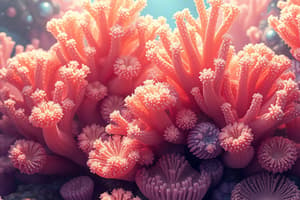Podcast
Questions and Answers
What is the defining cell type found in Poriferans?
What is the defining cell type found in Poriferans?
- Choanocyte (correct)
- Osculum
- Ostia
- Spicule
Which of the following is NOT a method of reproduction in sponges?
Which of the following is NOT a method of reproduction in sponges?
- Budding
- Binary fission (correct)
- Fragmentation
- Formation of gemmules
What is the function of the ostia in sponges?
What is the function of the ostia in sponges?
- Exits water after circulation
- Allows water to flow into the spongocoel (correct)
- Aids in reproduction
- Provides structural support
Which class of sponges is characterized by calcareous spicules?
Which class of sponges is characterized by calcareous spicules?
What role do sponges play in the environment?
What role do sponges play in the environment?
Which of the following statements about Poriferans is true?
Which of the following statements about Poriferans is true?
What is the large central cavity in a sponge called?
What is the large central cavity in a sponge called?
What type of spicules are found in the class Hexactinellida?
What type of spicules are found in the class Hexactinellida?
What type of skeleton do sclerospongiae or coraline sponges have?
What type of skeleton do sclerospongiae or coraline sponges have?
Which phylum is known for exhibiting radial or biradial symmetry?
Which phylum is known for exhibiting radial or biradial symmetry?
What is the primary function of the gastrovascular cavity in cnidarians?
What is the primary function of the gastrovascular cavity in cnidarians?
Which class of cnidarians includes the 'true-jellyfish'?
Which class of cnidarians includes the 'true-jellyfish'?
What type of body plan is exclusively exhibited by class Anthozoa?
What type of body plan is exclusively exhibited by class Anthozoa?
Which class of cnidarians contains the most venomous species?
Which class of cnidarians contains the most venomous species?
What is a characteristic feature of class Hydrozoa?
What is a characteristic feature of class Hydrozoa?
What structure aids in the attachment of Hydrozoa to substrates?
What structure aids in the attachment of Hydrozoa to substrates?
Flashcards are hidden until you start studying
Study Notes
Phylum Porifera
- Simplest group of multicellular animals (metazoans)
- Characterized by choanocytes (flagellated collar cells)
- Includes sponges
- Over 5,000 species
- Filter-feeding organisms
- Body structure facilitates water movement for feeding, waste removal, and gas exchange
- Reproduce sexually and asexually
- Fragmentation
- Budding
- Gemmule formation
- Hermaphroditic
Anatomy of Sponges
- Spongocoel: Central cavity lined with choanocytes
- Ostia: Pores on the side of the sponge that allow water to flow into the spongocoel
- Osculum: Large opening where water flows out after passing through the spongocoel
- Spicules: Skeletal structures made of silica or calcium carbonate
- Spongin: A fibrous protein that provides support
Classification of Sponges
- Four classes based on spicule type:
- Calcarea: Calcareous spicules (calcium carbonate)
- Hexactinellida: Six-rayed siliceous spicules (glass)
- Demospongiae: Siliceous spicules, spongin, or both
- Sclerospongiae: Multilayered calcium carbonate skeletons
Canal Systems of Sponges
- Ascon, Sycon, Leucon: Different structural designs for water flow, each with increased efficiency and complexity
- Enable filter-feeding
Phylum Cnidaria
- Exhibit radial or biradial symmetry
- Defining cell type: cnidocyte, a stinging cell used for prey capture and defense
- Two distinct body plans:
- Polyp: Stalk-like form, sessile
- Medusa: Bell-like form, free-swimming
- Gastrovascular cavity functions in digestion and circulation
- Gas exchange by diffusion
- Over 10,000 described species
Class Hydrozoa
- Includes 3,200 species
- Marine and freshwater dwellers
- Polyp form is dominant
- Examples: Hydras, Obelia
- Some colonial forms
Class Scyphozoa
- “True-jellyfish”
- 200 known species
- Exclusively marine
- Dominant medusa stage
- Bell-like morphology
- Free-swimming
Class Cubozoa
- “Box jellyfish”
- Solitary animals
- Reduced polyp stage
- All marine
- Muscular pads called pedalia
- Some of the most venomous cnidarians
Class Anthozoa
- Over 6,100 described species
- Sessile polyp stage only
- All marine
- Colonial or solitary
- Examples: Sea anemones, corals
Studying That Suits You
Use AI to generate personalized quizzes and flashcards to suit your learning preferences.




